
Reynoutria japonica, synonyms Fallopia japonica and Polygonum cuspidatum, is a species of herbaceous perennial plant in the knotweed and buckwheat family Polygonaceae. Common names include Japanese knotweed and Asian knotweed. It is native to East Asia in Japan, China and Korea. In North America and Europe, the species has successfully established itself in numerous habitats, and is classified as a pest and invasive species in several countries. The plant is popular with beekeepers, and its young stems are edible, making it an increasingly popular foraged vegetable with a flavour described as lemony rhubarb.

Polygonum is a genus of about 130 species of flowering plants in the buckwheat and knotweed family Polygonaceae. Common names include knotweed and knotgrass. In the Middle English glossary of herbs Alphita, it was known as ars-smerte. There have been various opinions about how broadly the genus should be defined. For example, buckwheat has sometimes been included in the genus as Polygonum fagopyrum. Former genera such as Polygonella have been subsumed into Polygonum; other genera have been split off.
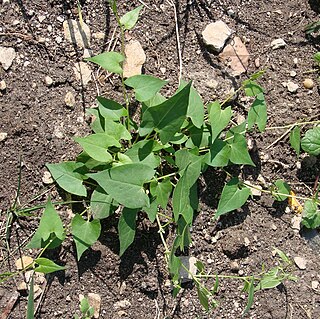
Fallopia convolvulus, the black-bindweed or wild buckwheat, is a fast-growing annual flowering plant in the family Polygonaceae native throughout Europe, Asia and northern Africa.

Fallopia is a genus of about 12 species of flowering plants in the buckwheat family, often included in a wider treatment of the related genus Polygonum in the past, and previously including Reynoutria. The genus is native to temperate and subtropical regions of the Northern Hemisphere, but species have been introduced elsewhere. The genus includes species forming vines and shrubs.

Allium nigrum, common name black garlic, broad-leaved leek, or broadleaf garlic, is a Middle Eastern species of wild onion. It lacks the onion or garlic scent shared by most of the other species in the group. The species is native to Turkey, Cyprus, Syria, Lebanon, and Israel but cultivated as an ornamental in many other places. It has become naturalized in some regions, including parts of the United States.
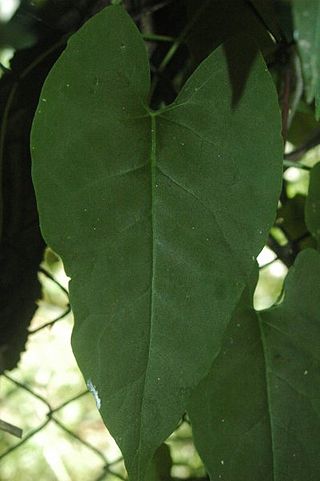
Reynoutria multiflora is a species of flowering plant in the buckwheat family Polygonaceae native to central and southern China. It is known by the English common names tuber fleeceflower and Chinese (climbing) knotweed. It is known as he shou wu in China and East Asia. Another name for the species is fo-ti, which is a misnomer.

Reynoutria sachalinensis is a species of Fallopia native to northeastern Asia in northern Japan and the far east of Russia.
× Reyllopia is a hybrid genus with a single known species, × Reyllopia conollyana, the Haringey knotweed or railway-yard knotweed. The species is a hybrid between Japanese knotweed and the Russian vine. The only known wild British population was discovered by David Bevan at Railway Fields in 1987.
Aphalara itadori, the Japanese knotweed psyllid, is a species of psyllid from Japan which feeds on Japanese knotweed.

Fallopia baldschuanica is an Asian species of flowering plant in the knotweed family known by several common names, including Russian-vine, Bukhara fleeceflower, Chinese fleecevine, mile-a-minute and silver lace vine. It is native to Asia, and is growing wild in parts of Europe and North and Central America as an introduced species.
Coleophora cecidophorella is a moth of the family Coleophoridae. It is found in France, Italy, Austria, Slovenia, Croatia, the Czech Republic, Slovakia, Hungary, Romania and Ukraine.
Coleophora pratella is a moth of the family Coleophoridae. It is found from France and Belgium to Latvia, Lithuania, Poland, Romania and Bulgaria and from Germany to Italy, Austria and Hungary.

Fallopia aubertii is a species of flowering plant in the knotweed family Polygonaceae.

Monochroa sepicolella is a moth of the family Gelechiidae. It is found from central and northern Europe to the Ural Mountains, the Caucasus and southern Siberia.
Ann P. Conolly (1917–2010) was a British botanist and teacher who contributed to quaternary botany and conducted important early work on the history and spread of Japanese Knotweed in the UK.
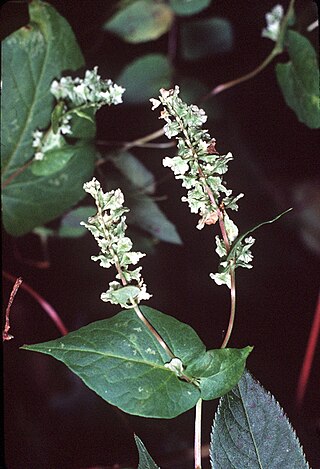
Fallopia scandens, the climbing false buckwheat, is a species of Fallopia native to North America. It is a herbaceous perennial plant which grows from to 1–5 m (3–16 ft) tall. Although they are semi-erect during bloom, when they are producing fruit, they hang from their pedicels in a downward position. Both the fruit and flower are greenish-white in appearance. In North America, it is often misidentified with Fallopia dumetorum, a species endemic to Europe.

Reynoutria is a genus of flowering plants in the Polygonaceae, also known as the knotweed or buckwheat family. The genus is native to eastern China, Eastern Asia and the Russian Far East, although species have been introduced to Europe and North America. Members of the genus, including R. japonica and its hybrid with R. sachalinensis, are highly invasive plants.

Polygonoideae is a subfamily of plants in the family Polygonaceae. It includes a number of plants that can be highly invasive, such as Japanese knotweed, Reynoutria japonica, and its hybrid with R. sachalinensis, R. × bohemica. Boundaries between the genera placed in the subfamily and their relationships have long been problematic, but a series of molecular phylogenetic studies have clarified some of them, resulting in the division of the subfamily into seven tribes.
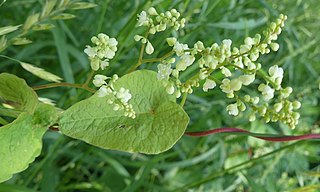
Polygonum ciliinode is a species of flowering plant in the family Polygonaceae, native to central and eastern Canada, and the north-central and eastern United States. The specific epithet is also spelt cilinode.
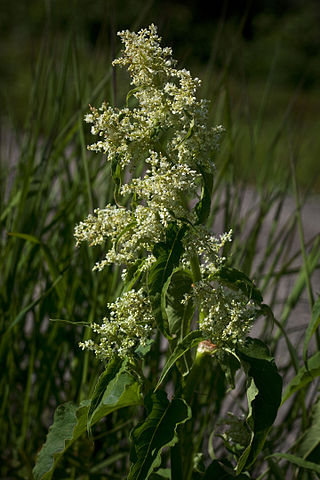
Tanja Magdalena Schuster is a taxonomist from Austria, and the first Pauline Ladiges Plant Systematics Fellow, holding a joint position with the School of Biosciences, University of Melbourne, Victoria, Australia, and the National Herbarium of Victoria, Royal Botanic Gardens Melbourne. Schuster also worked as curator of the Norton-Brown Herbarium at the University of Maryland, College Park.














